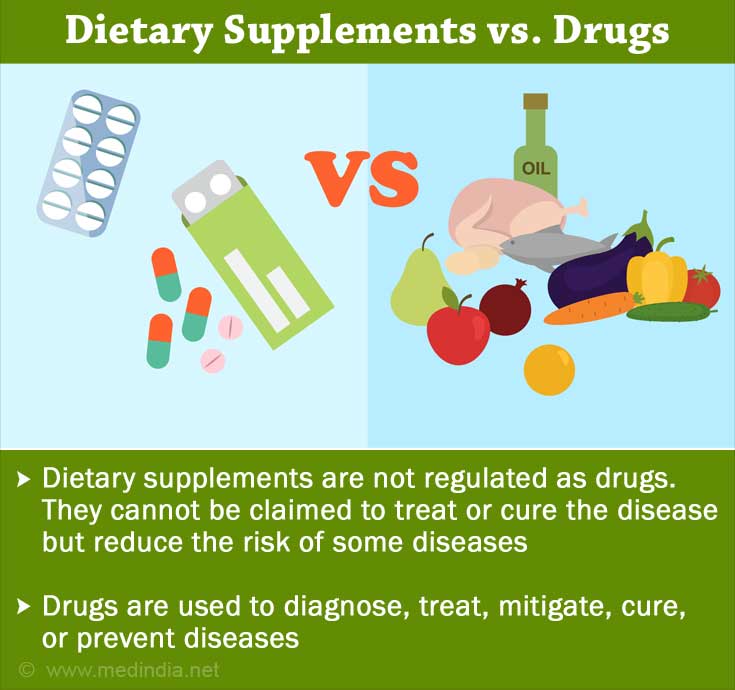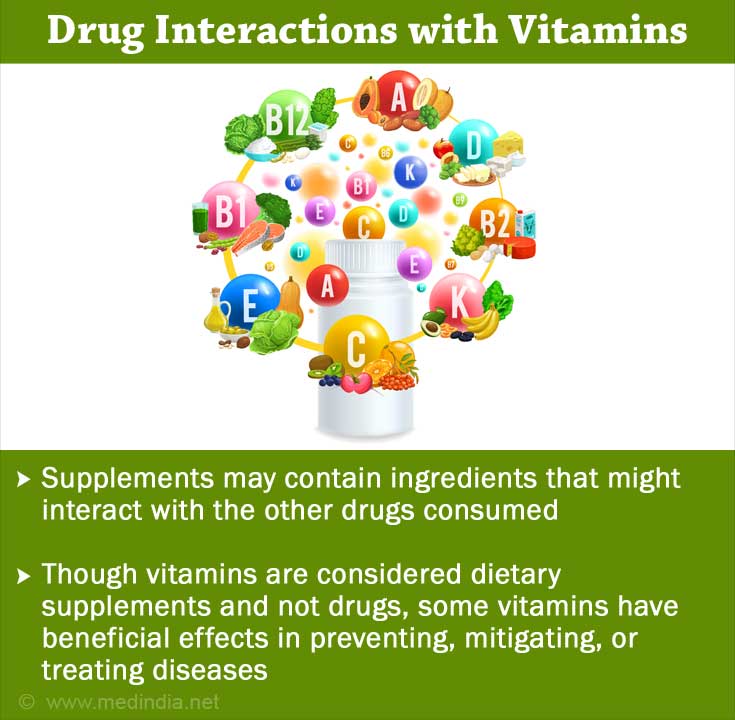- Vitamins: Their Functions and Sources - (https://www.uofmhealth.org/health-library/ta3868)
- Godswill, A. G., Somtochukwu, I. V., Ikechukwu, A. O., & Kate, E. C. (2020). Health benefits of micronutrients (vitamins and minerals) and their associated deficiency diseases: A systematic review.International Journal of Food Sciences,3(1), 1-32 - (https://doi.org/10.47604/ijf.1024)
- Dietary Supplements
- Drugs@FDA Glossary of Terms - (https://www.fda.gov/drugs/drug-approvals-and-databases/drugsfda-glossary-terms)
- FDA 101: Dietary Supplements - (https://www.fda.gov/consumers/consumer-updates/fda-101-dietary-supplements)
- Dietary Supplements - What You Need To Know - (https://ods.od.nih.gov/factsheets/WYNTK-Consumer/)
- Sulli, M.M.,&Ezzo, D.C. (2007). Drug interactions with vitamins and minerals. U.S. Pharmacist, 32. 42-55. - (https://ods.od.nih.gov/factsheets/WYNTK-Consumer/)
- Yetley, E. A.(2007). Multivitamin and multimineral dietary supplements: Definitions, characterization, bioavailability, and drug interactions. The American Journal of Clinical Nutrition, 85(1), 269S-276S - (https://doi.org/10.1093/ajcn/85.1.269S)
- What is vitamin A and what does it do? - (https://ods.od.nih.gov/factsheets/VitaminA-Consumer/)
- What is vitamin D and what does it do? - (https://ods.od.nih.gov/factsheets/VitaminD-Consumer/)
- What is folate and what does it do? - (https://ods.od.nih.gov/factsheets/Folate-Consumer/)
- Dehghani-Samani, A., Kamali, M.,&Hoseinzadeh-Chahkandak, F. (2020). The role of vitamins on the prevention and/or treatment of COVID-19 infection: Asystematicreview.Modern Care Journal, 17(3), e104740. doi - (10.5812/modernc.104740.)
- Fairfield, K. M., & Fletcher, R. H. (2002). Vitamins for chronic disease prevention in adults:Scientificreview.JAMA, 287(23), 3116-3126 - (doi:10.1001/jama.287.23.3116)
What are Vitamins and their Functions?
Micronutrients that include vitamins and minerals are essential in varying amounts for every organism to run critical physiological functions. Vitamins are organic compounds that are required for the human body in milligrams or micrograms. Though the requirement is less, their deficiency is very common.
The right diet, vitamin supplements, and fortification of foods are the common approach to combat vitamin deficiency. Vitamins are of 13 types and grouped as fat-soluble and water-soluble vitamins. The list of vitamins and their functions are given below:
Fat-soluble vitamins: Vitamins A, D, E, and K are classified as fat-soluble vitamins. These vitamins are digested and absorbed with the aid of lipids in the intestine. Fat-soluble vitamins A and D are essential for good skin, vision, healthy bones, and teeth. Vitamin E acts as an antioxidant and scavenging radical, and vitamin K is needed for blood clotting.
Water-soluble vitamins: Vitamins C and B are classified as water-soluble vitamins. Water-soluble vitamins are dissolved in water and excreted rapidly from the body. B vitamins are of eight types B1, B2, B3, B5, B6, B7, B9, and B12. B vitamins play vital roles in energy metabolism, nervous functions, vision, skin health, digestion, red blood cells production, DNA synthesis, scavenging radicals, and many more. Vitamin C acts as an antioxidant, aids in immune function and non-heme iron absorption.
Dietary supplements versus Drugs
According to the U.S. Food and Drug Administration (FDA), dietary supplements are not regulated as drugs, but foods, and have a ‘dietary ingredient.’ The dietary ingredients could be vitamins, minerals, herbs, enzymes, and amino acids. Dietary supplements cannot be claimed to treat or cure diseases; however, supplements have been presented to reduce the risk of some diseases.

According to the FDA, drugs are referred to as a substance excluding food that impacts the body’s function and is used to diagnose, treat, mitigate, cure, or prevent disease. FDA defines Over-the-Counter (OTC) drugs as those that can be used by the public without the need for a doctor’s prescription.
The FDA sets different regulations for dietary supplements when compared to prescription or OTC medicines.
How and When Vitamins are Used as Drug?
Vitamin A plays a vital role in vision, reproductive, and immune health. Vitamin A deficiency is a risk factor for measles. Supplementing high doses of vitamin A can reduce symptoms like fever and diarrhea, and bring down the risk of death in children with measles.
Loss of central vision or age-related macular degeneration common among older adults can be slowed down with supplementation of antioxidants, zinc, copper, and with or without beta-carotene. Vitamin A supplementation has also displayed enhancing effects on antibody titers.
Vitamin D is essential for maintaining strong bones and teeth. Vitamin D and calcium supplementation may aid in preventing osteoporosis, reducing bone loss, and improving bone strength in the elderly. Few studies reported that vitamin D supplements lowered blood cholesterol levels and blood pressure, thereby promoting heart health. Vitamin D deficiency is associated with an increased risk of multiple sclerosis. However, the clinical evidence on the effectiveness of vitamin D supplementation for multiple sclerosis is thin.
Vitamin C, an effective antioxidant, has been studied to prevent coronary heart disease. The COVID-19 pandemic has propelled vitamins into the limelight for boosting immunity. Many studies and protocols for the prevention and treatment of COVID-19 infection have focused on vitamins A, D, E, and C. Hence, suggesting adequate vitamin intake to prevent infections, including COVID-19 infection.
Folic acid (Vitamin B9) is required for healthy DNA synthesis and cell regulation. Folic acid supplementation has shown strong results in preventing neural tube defects in newborns. Folic acid may also taper the risk of delivering preterm babies.
People with folate deficiency might experience depression. Supplementing the vitamin will improve the efficacy of antidepressants medications. Homocysteine is an amino acid and a marker of heart disease. Supplementing folic acid has been shown to bring down homocysteine levels but does not directly reduce the risk for heart disease.
However, a few studies have reported that combining folic acid with other B vitamins may help prevent stroke. Studies have also revealed that taking folic acid before and during early pregnancy may help diminish the risk for Autism Spectrum Disorder (ASD) in babies.
A study reported that long-term ingestion of multivitamins for more than 10 years reduced the risk for colon cancer by 25%. Multivitamin supplementation has also been shown to reduce breast cancer risk by 25%.
Although several studies showed the beneficial effects of vitamins on health, the exact mechanism of most vitamins is unknown and the clinical evidence for some is inadequate.
Drug Interactions with Vitamins
It is important to note that supplements may contain ingredients that might interact with the other drugs consumed.

- Vitamin A: Retinoids such as Isotretinoin and Acitretin are used in treating acne and psoriasis. These products possess a concern for vitamin A toxicity; if along with these drugs, vitamin A is taken in excess. Drugs like abciximab, ancrod, phenindione, when combined with vitamin A, may increase the risk of bleeding.
- Vitamin E has been shown to increase the risk of bleeding when administered along with warfarin, an anticoagulant. Cholestyramine (used to lower cholesterol levels) reduces the absorption of fat-soluble vitamins and decreases their absorption.
- Vitamin K: Warfarin is an anti-coagulant, and vitamin K enables blood clotting. Hence, when these both are administered together efficacy of the drug warfarin is reduced.
- Vitamin B3 (Niacin): Statins are used to treat abnormal cholesterol levels. Combining niacin and statins like HMG-CoA reductase inhibitors might increase the risk for myopathy (muscle weakness). Cholesterol-lowering drugs like cholestyramine and colestipol may also reduce the absorption of niacin.
- Vitamin B6 (Pyridoxine): Pyridoxine can reduce the effect of drugs like phenytoin (to treat epilepsy) and levodopa. However, levodopa, when administered along with carbidopa, counteracts this interaction. Limited evidence shows that large doses of pyridoxine will reduce the serum concentrations of phenytoin and have made it less effective. A combination of contraceptives (combination) and pyridoxine can increase the requirement of the vitamin.
- Vitamin B9 (Folic acid): Methotrexate is administered to treat cancer, psoriasis, and rheumatoid arthritis. This drug can cause folic acid deficiency. It is also important to note that folic acid has been shown to reduce the efficacy of methotrexate when used for cancer therapy. When folic acid is combined with phenytoin or fosphenytoin, the concentration of phenytoin decreases.
- Vitamin B12 (Cobalamin): Drugs used to treat digestive disorders like omeprazole, cimetidine, and ranitidine can reduce the absorption of the vitamin. Contraceptives, when combined with B12, might decrease the serum concentrations of the vitamin.
- Vitamin C (Ascorbic acid): Indinavir (used to treat HIV) reduces the plasma concentrations of the drug when combined with vitamin C.
Vitamins are essential nutrients and cannot be synthesized in the body or are produced in short supply. Though vitamins are considered dietary supplements and not drugs, some out of the 13 vitamins have displayed beneficial effects in preventing, mitigating, or treating diseases.









